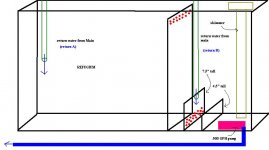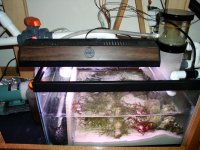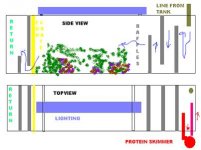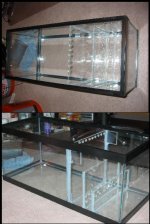I have built this from a 20 long and will try to get it in my system in a week or so. I have some of the parts on order so I still have time for edits. I am going to distribute the 500 GPH feed via two outlets in the main (44 gallon). All plumbing will be 3/4" PVC and will feed back thru a 600 GPH rated overflow box.
I plan on allowing most of the return flow down "Return B" to keep flow thru my fuge at a minimum.
The red circles are large perforations (drilled with a 7/16" bit). I calculated the total surface area of the perforations in the fuge wall to be 1.7 sq. in. and the main baffle to be 3.26 sq. in. Now, I assume that those surface areas are plenty to flow ~150 and 500 GPH respectivly. I want to flow about 150 GPH through the refugium (return A) and the rest through return B so all of the water will have to go thru the baffle perfs.
The other baffle will be for additional air bubble reduction.
I plan on keeping the depth of water in the pump/skimmer area about 4 - 4.5".
The pump is a Mag-Drive 5.
Ideas? Flaws? Problems?
Thanks.
I plan on allowing most of the return flow down "Return B" to keep flow thru my fuge at a minimum.
The red circles are large perforations (drilled with a 7/16" bit). I calculated the total surface area of the perforations in the fuge wall to be 1.7 sq. in. and the main baffle to be 3.26 sq. in. Now, I assume that those surface areas are plenty to flow ~150 and 500 GPH respectivly. I want to flow about 150 GPH through the refugium (return A) and the rest through return B so all of the water will have to go thru the baffle perfs.
The other baffle will be for additional air bubble reduction.
I plan on keeping the depth of water in the pump/skimmer area about 4 - 4.5".
The pump is a Mag-Drive 5.
Ideas? Flaws? Problems?
Thanks.









